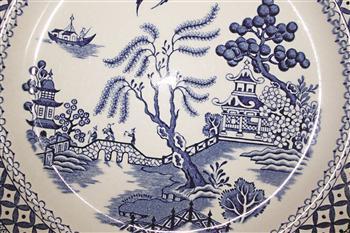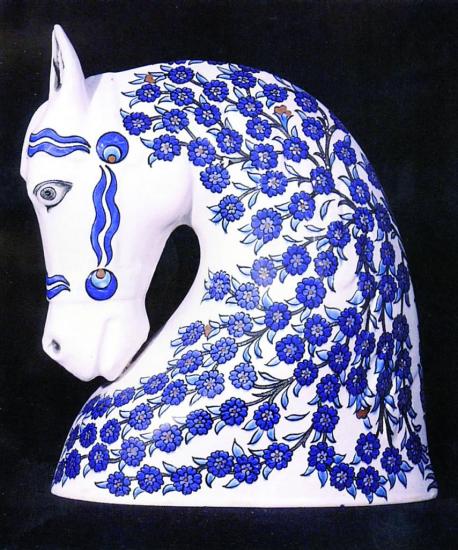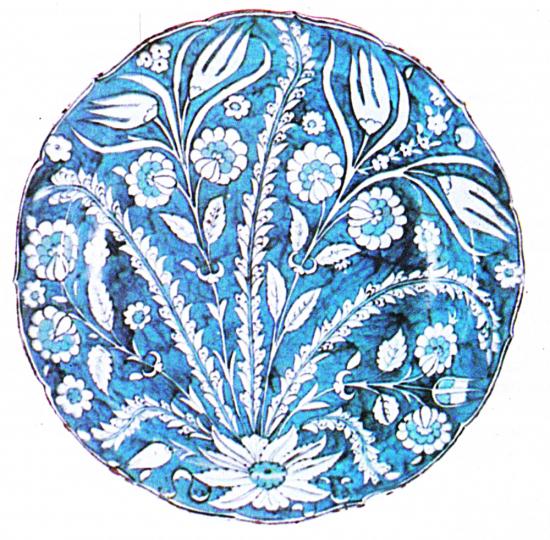One of the areas to which blue-white Chinese porcelain was exported was Istanbul and in particular to the imperial court at Topkapı Palace. The first use of Chinese porcelain was in 1457
Niki Gamm
Source - http://www.hurriyetdailynews.com/the-blue-white-ceramics-of-china-and-iznik.aspx?pageID=238&nID=53981&NewsCatID=375

Blue-white pottery refers to the elegantly painted, blue and white Chinese and İznik tiles and ceramics that were and are highly prized by their owners. Their journey has been a long one, starting with the discovery of cobalt blue in Iran that was mined from the 9th century CE and exported to China mostly as a raw material. There are, however, a very few examples of blue-white pottery that have been found in Iran, with Arabic inscriptions on them from about the same period, suggesting that the blue-white technique went along with the raw material.
The first Chinese blue-white also occur in the 9th century although only fragments have been found. The earthenware continued to be used and admired until it reached an apex in the 14th century. By then, blue-white was being extensively exported to other lands in the Far East and along the famed Silk Road, thanks to the spread of Islam. Early in the 14th century, the blue-white technique was applied to porcelain and the results produced were filled with floral and geometric patterns that suited Muslim tastes. Better quality cobalt blue from Persia contributed to the finer designs. Robert Finlay, in his book “The Pilgrim Art,” notes that cobalt blue went for twice the price of gold.

First use of Chinese porcelain
One of the areas to which blue-white Chinese porcelain was exported was Istanbul, and in particular to the imperial court at Topkapı Palace. The first recorded of Chinese porcelain was in 1457 at the circumcision ceremonies for Fatih Sultan Mehmed II’s two sons, Bayezid and Mustafa, but we aren’t told if these were blue-white. An inventory at Topkapı in 1496 is the first time porcelain is mentioned in that location. The total collection at Topkapı, achieved through war, plunder, gifts and unclaimed inheritance, numbers more than 10,000. Of this, more than half of these are blue-whites and represent a timeframe dating from the middle of the 14th century to the nineteenth.
Alongside the Chinese porcelain are the blue-white tiles and porcelain produced at İznik from the first half of the 15th century to the middle of the 16th. These were at first based on fifteenth century Ming dynasty porcelains that included flowers, clouds and even dragons. İznik was the first Turkish capital in Anatolia and it never lost its importance in the Ottoman period for its successful production of tiles.
Topkapı Palace supported İznik tile-making, gradually increasing the orders it placed with ateliers there.
Ceramic items for daily use are to be found in the Topkapı kitchens and on the tables of the wealthy.
İznik tiles were also exported even through special offers from abroad. In the recently published book “Turkish Tiles” by Ozlem İnay Erten and Oğuz Erten, the authors noted that the palace kitchen registers dated 1582 show that 541 İznik plates and cooking pans were purchased from the Istanbul market for the circumcision of Sultan Murad III’s son Prince Mehmed.
In fact, the İznik ceramics were fashionable throughout the Mediterranean, the Balkans and Europe. The early works produced in Italy seemed to have been a mixture of Islamic and Chinese designs which would hardly be surprising as both would have arrived there via the Ottoman Empire in the 16th century. Direct imitation of the Chinese ware, however, had to wait until the next century when civil disturbances in China disrupted trade. The Italians then turned to copying from already extant pieces and after the Italians the production of ceramic wares began to emerge in the Netherlands.
In a recent CNN interview with the Netherlands’ 360-year-old Royal Delft Group CEO Henk Schouten, the point was made that “Royal Delft itself was influenced by Chinese pottery, after Dutch tradesmen brought back porcelain from the Far East in the 1600s. It proved popular with the Dutch, and potters began developing a similar style with local clay.” This was the result of Dutch trading directly with the Far East. Today blue-white Delft ware is among the finest produced throughout the world.
 Technique matters
Technique matters
Blue-white may be divided into four types including the best tiles produced in İznik in the late fifteenth and early sixteenth centuries. They can be either blue on white or white on blue on smooth, hard dough. The transparent underglazing has differing shades of blue for such designs as flowers, stylized clouds and dragons that show the influence of the Chinese. In some cases kufic and nesih calligraphy appears. Between 1520 and 1540 turquoise was added from time to time to the blue-white.
Rare blue-white ceramics
The best of the blue-white ceramics are the extremely rare examples in which delicate flowers and tiny leaves form a chain around a spiral. This design for a long time was called “Golden Horn” ware but now that many examples have been found in excavations in İznik it is acknowledged that the center of production was İznik.
Underglazing, a basic method applied for centuries in Anatolia, is used to produce the stunning blue-white porcelain. It consists of firing the clay that has been molded or hand-shaped into the desired form and glazed with a tin-based glaze. It is then taken out, cooled and painted with designs which are applied by drawing them on paper and then pricking small holes in the paper. The paper is then fitted over the clay surface and charcoal dust poured over it. This leaves the design right on the clay surface, ready for the paint to be applied. Once the painting is finished, a colored or colorless tine-based glaze is applied over it and it’s re-fired.
For those people interested in blue-white İznik and Chinese porcelain, Topkapı Palace Museum has examples in its Çinili Köşk (Tile Villa) located on the grounds of the Istanbul Archaeological Museums. By the end of the year the Topkapı kitchens should once again be open to the public where the palace collection of Chinese porcelains will be on display. It has the largest collection of Chinese porcelain outside of China. Another place in Istanbul where İznik tiles and Chinese porcelain can be seen, according to its website, is “the Sadberk Hanım Museum which has one of the leading collections in the world.
İznik ceramics on display including wares for daily use like plates, bowls, vases and jugs decorated in a naturalistic style with rose, tulip, carnation and hyacinths motifs and tiles manufactured for mosques, tombs, madrasahs, hammams with designs prepared in the palace workshop, show the development in İznik ceramic art from the end of 15th till the middle of the 17th century.
Sadberk Hanım Museum’s collection of Chinese porcelain is a modest one, but it includes unique pieces. The collection is an important treasure for the ones who are interested in examining the Chinese porcelains used during the Ottoman period.”